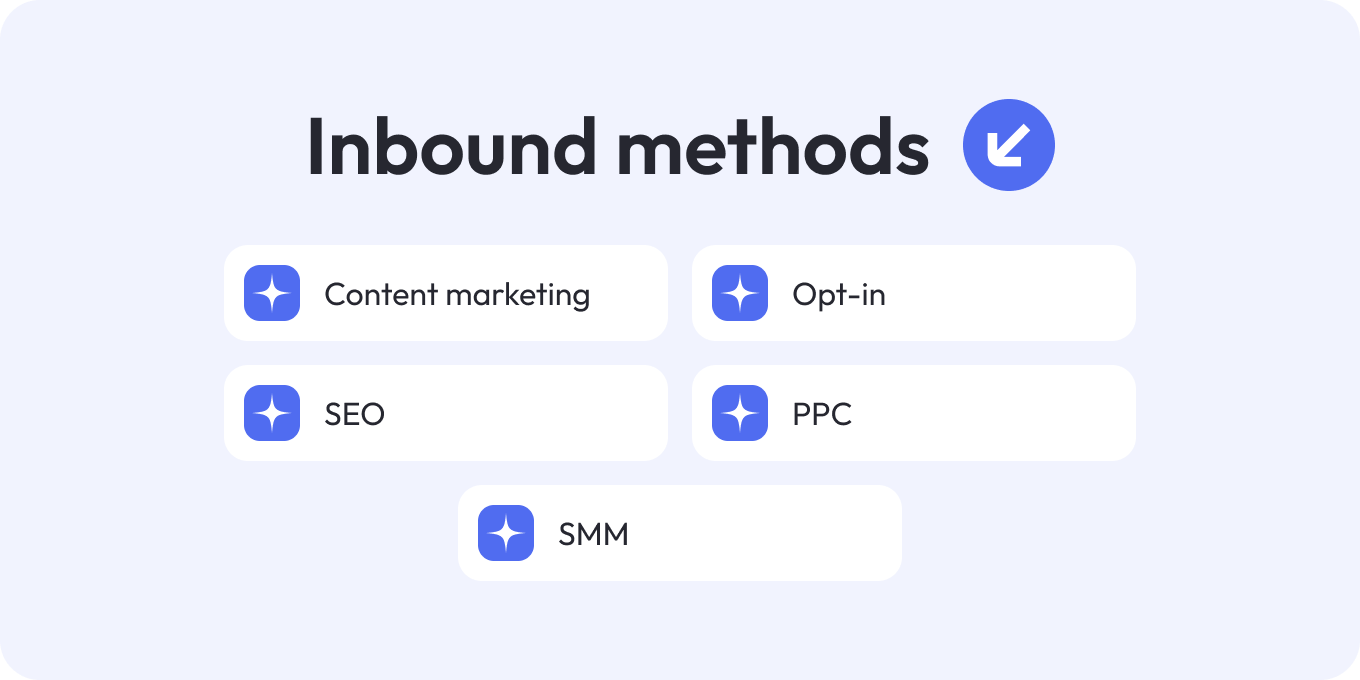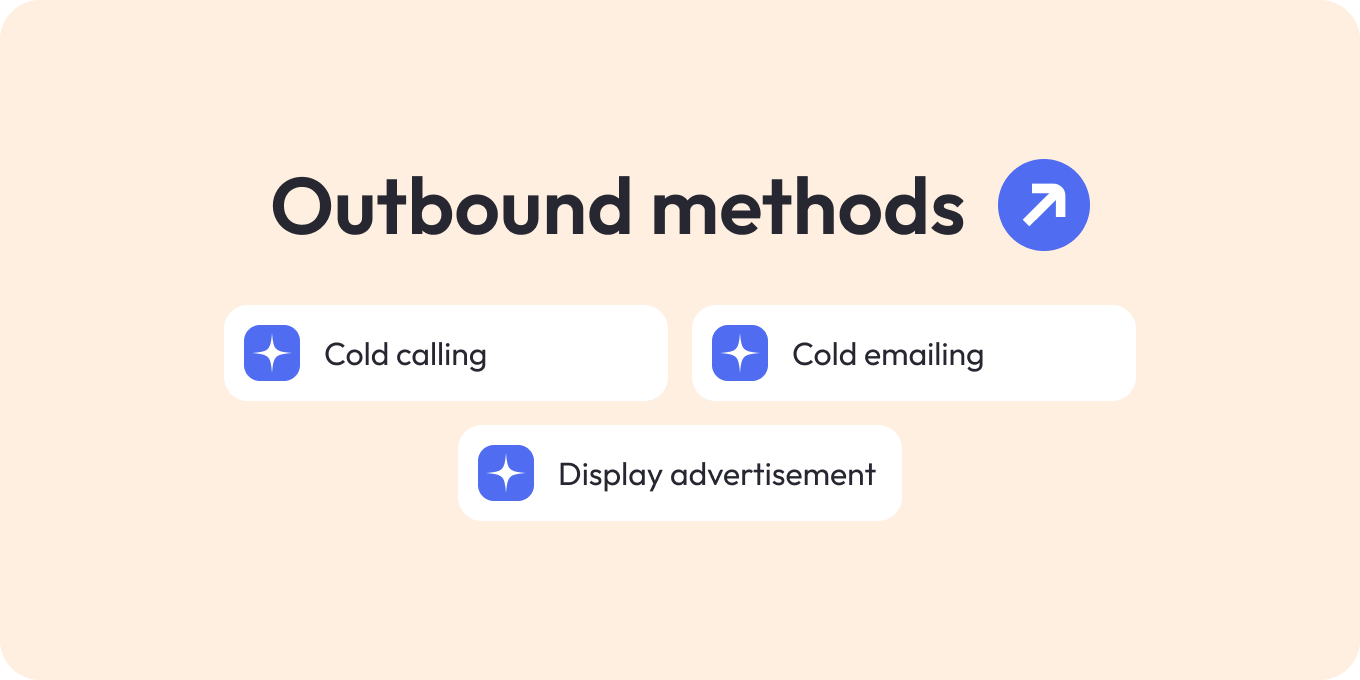- Blog
- /
- Popular articles
- /
- Advantages and limitations of inbound and outbound lead generation methods
Table of contents
Advantages and limitations of inbound and outbound lead generation methods

- #B2B
- #Customer Success
- #Sales
- 10 min read
- Posted:
Lead generation is crucial for building a customer base, and businesses often use a combination of inbound and outbound approaches. Each method comes with its own set of advantages and limitations, making it essential for companies to choose the right balance depending on their goals and resources.
Inbound lead generation approach
Inbound lead generation is a method of attracting customers that have somehow shown interest in your product or service. The main concept of inbound marketing is permission or customers’ interest. You do not interrupt the audience with your content, instead, they are searching for it.
More about these approaches you can find in our article about Inbound and Outbound marketing methods in lead generation.
Now let’s talk about the methods of inbound lead generation.

Content marketing
Content marketing involves creating and distributing relevant content to attract a specific, well-defined audience. This approach often overlaps with strategies like SEO (Search Engine Optimization) and SMM (Social Media Marketing), as both play key roles in boosting visibility and engagement. Content marketing typically includes blogs, videos, infographics, and guides, all designed to keep the audience interested and engaged while positioning your brand as a valuable resource.
Advantages:
– Builds trust and authority by providing valuable, engaging content.
– Draws in an interested audience organically, who are likely to be more receptive.
– Can establish long-term relationships and improve customer loyalty.
Limitations:
– Time-consuming to research, create, and distribute high-quality content.
– Difficult to measure ROI accurately, especially if combined with other marketing efforts.
– Requires continuous effort to keep content fresh and engaging.To come up with catchy content, you should have great skills in analyzing and telling stories.
SEO
SEO, or search engine optimization, is the process of improving a website’s visibility and rankings on search engines like Google, Bing, and others. It involves optimizing various elements of a website, including content, keywords, meta tags, and backlinks, to ensure that it ranks higher for relevant search queries. The goal is to attract more organic traffic by appearing on the first page of search engine results, where users are more likely to click and engage with your site. SEO strategies also include technical aspects like page speed, mobile optimization, and user experience, which play crucial roles in ranking algorithms.
Advantages:
– Brings in targeted traffic with long-term potential for lead generation.
– Once established, leads become cheaper as they are generated organically.
– Enhances brand credibility through high search rankings.
Limitations:
– Expensive and time-consuming to achieve significant results.
– Requires ongoing efforts to maintain rankings due to search engine algorithm changes.
– No immediate ROI; results often take months or longer to materialize.
SMM
SMM or Social Media Marketing is a technique of using social networks to promote your product or service. The goal of SMM is to expand brand awareness and engage customers.
Advantages:
– Low cost of entry with the potential for viral content.
– Builds personal connections and trust with the audience.
– Offers vast reach, with billions of active users across platforms like Facebook and Instagram.
Limitations:
– Time-intensive and requires consistent daily interaction.
– Difficult to measure the direct ROI from social media activities.
– Vulnerable to negative feedback and public comments that can damage brand reputation.
Opt-in
Opt-in email marketing is the opposite of cold emailing, as it relies on customers willingly signing up to receive communications from a company. This makes it an inbound method, meaning the company only sends emails to people who have expressed interest by opting in. These emails typically contain newsletters, promotions, product information, or special offers.
There are two types of opt-ins:
- Single Opt-in: The user provides their email address without additional verification, so they are immediately added to the mailing list.
- Double Opt-in: After submitting their email, the user receives a confirmation link. They must click the link to be officially added to the mailing list, ensuring greater accuracy and engagement from genuinely interested users.
Advantages:
– High engagement, as users have actively chosen to receive information.
– Personalizes communication and builds stronger relationships with leads.
Limitations:
– Requires a carefully nurtured email list to avoid spam filters.
– Double opt-in methods can slow down list growth due to extra steps for the user.
PPC
PPC is sometimes considered as an outbound method, but the vast majority of the time it is used as a method of an inbound approach. Pay-per-click advertisement is based on keywords, so it is not you who reaches the client. The client themself is searching for you. That is why with PPC you can reach your desired audience.
Advantages:
– Provides instant visibility in search engines.
– Can be highly targeted based on keywords and demographics, improving lead quality.
Limitations:
– Expensive, especially in competitive industries.
– Lead generation stops once the budget is exhausted, making it less sustainable long-term.
Outbound lead generation approach
Outbound lead generation is a strategy used to reach potential customers who are not yet familiar with your product or service. Unlike inbound methods, outbound lead generation actively seeks out prospects, often disrupting their current activity. This approach includes tactics like cold calling, cold emailing, direct mail, and paid advertising.
The key feature of outbound methods is that they interrupt the customer’s information flow, presenting a product or service when the customer isn’t necessarily looking for it. While this can be effective for brand awareness, it may also face resistance if perceived as intrusive.

Cold calling
Cold calling is a marketing method of outbound lead generation. You contact a potential customer who has never expressed interest in your product via call.
Advantages:
– Immediate interaction with potential customers, allowing for instant feedback.
– Opportunity to build a personal rapport and handle objections in real-time.
Limitations:
– Low conversion rate, with less than 1% of calls typically leading to a sale.
– Time-consuming and often leads to frustration, damaging brand reputation.
– Expensive due to the labor-intensive nature of the process.
Cold emailing
Cold mailing is similar to cold calling, the only difference in the used contact channels.
Advantages:
– Scalable and cost-effective; easy to automate and reach a large audience.
– Less intrusive than cold calling, allowing prospects to respond on their own time.
Limitations:
– Lower open and response rates due to spam filters and email overload.
– Can hurt brand image if emails are perceived as spammy or irrelevant.
Display advertisement
Display advertising is a form of paid advertising. Display advertising refers to ads on websites, apps, and social media platforms.
Advantages:
– Wide reach, allowing you to target specific demographics across the internet.
– Immediate visibility to a large audience.
Limitations:
– Ad blockers reduce visibility, with many users avoiding these ads.
– Decreasing click-through rates, making it less effective over time.
Consumers have become more particular about what they want to see on their screens. According to a Moz survey, about 58% of users install Adblockers to protect themselves from interruption. It means your ad can be simply blocked and will not have a chance to reach the target audience, therefore, to make new leads.
All above leads to a decrease in the click-through rate (CTR) rate. In 2020 CTR decreased by 32% since last quarter and about 41% lower year over year.
What to do with deciding effectiveness of classic lead generation methods?
Traditional lead generation methods are becoming less effective due to changing consumer behavior. Conversion rates for marketing-qualified leads (MQLs) are dropping, with only about 1% resulting in closed deals. Most customers now complete 70% of their buying journey before engaging directly with companies, often avoiding contact forms and remaining anonymous.
To stay ahead, businesses need to engage potential leads earlier, before they opt in. Social selling is a key strategy for building relationships and brand awareness early in the customer journey. Exploring modern tools and methods is crucial for adapting to today’s market.
- #B2B
- #Customer Success
- #Sales
- 10 min read
- Posted: